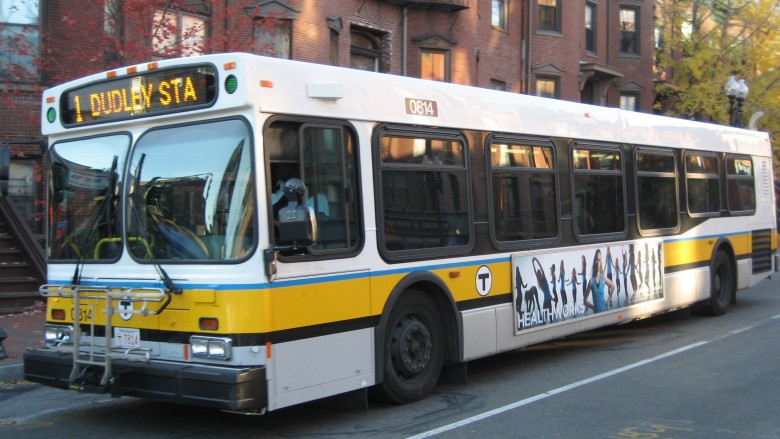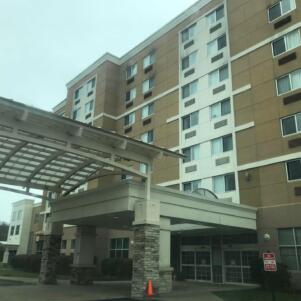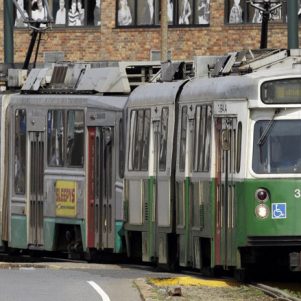T buses cost twice as much to maintain as Chicago’s, data show
By State House News Service | November 2, 2015, 18:55 EST
 An MBTA bus plies the Dudley Square run. (Photo courtesy of Wikipedia.)
An MBTA bus plies the Dudley Square run. (Photo courtesy of Wikipedia.) BOSTON – The Massachusetts Bay Transportation Authority’s bus maintenance costs run about twice as high as the Chicago Transit Authority and the T’s per-vehicle-hour maintenance spending is almost twice as high as the average for the state’s regional transit authorities, according to data presented Monday.
The T spends almost $41 per vehicle hour on bus maintenance compared with about $20 in Chicago and $24 on average at the state’s regional transit authorities, according to T data. Compared with similarly large urban systems, the T’s bus-repair costs are the highest per vehicle hour in the country, and behind only New York City as measured by vehicle miles.
“It’s a pretty stark picture,” Brian Shortsleeve, the T’s chief administrator, told reporters Monday ahead of a Fiscal and Management Control Board meeting where he briefed the members on the data.
As the T seeks to balance its budget,it plans to hire a consultant to provide a more extensive look at the bus maintenance costs. “Everything’s on the table,” Shortsleeve said.
MBTA officials have been in discussion with the International Association of Machinists and Aerospace Workers Local 264, which represents bus mechanics, and both sides reflected positive views about the collaboration.
“They’ve definitely been receptive,” said Russell Gittlen, the union’s New England director and a member of the MassDOT board of directors. “We look at things a little differently.”
Shortsleeve said staffing levels, productivity and wages should be looked at, and said the larger bus yards conduct repairs more efficiently than the smaller yards – such as the north Cambridge facility where 13 fulltime mechanics specifically handle electrically powered buses that use catenary lines.
“We’re doing this in nine places versus doing this in three or four places,” said Shortsleeve. He added that any consideration of consolidation would have to weigh capital costs and geographic needs. A Charlestown maintenance yard has 91 full-time-equivalent employees, as does an Everett facility that handles major repairs.
Craig Hughes, the mechanics’ union’s secretary-treasurer, said the T’s bus maintenance record – demonstrated by miles between breakdowns – is second only to Denver’s transit system, while Chicago and Minneapolis are “at the lower end of that scale.”
“Although we believe that there’s room to improve financially, the quality of bus service, the safety of bus service, the reliability of bus service matters,” Hughes told reporters. “And during the Snowmageddon, bus did not fail, and there’s a reason for that.”
The machinist union does not represent the North Cambridge workers.
Hughes also said in making comparisons to regional transit authorities, officials should recognize that many of those buses are smaller and simpler to maintain, and they operate on suburban roads rather than the heavily trafficked urban streets that carry many MBTA buses.
A spokesman for the Chicago Transit Authority said the system upgraded its maintenance facilities and upgraded its fleet of buses through overhauls and new purchases.
“Since 2011, CTA has made major investments to rehabilitate its bus and rail maintenance facilities which has helped to provide a more efficient work environment for our employees, and helped to speed up and lower costs of our vehicle repairs,” Jeff Tolman told the News Service in an email. He said, “CTA has also continued to work to acquire an almost entirely new bus fleet since 2011 by both purchasing new buses and rehabilitating older buses.”
Excluding Worcester’s transit authority, which is unique in not outsourcing maintenance, the state’s regional transit authorities are even less expensive – averaging about $15 per vehicle hour – and the work is undertaken by unionized workforces, Shortsleeve said. In systems such as Honolulu and Las Vegas, where maintenance is outsourced, the average spent per vehicle hour is $16, according to Shortsleeve.
After discussing potential revenue-generating opportunities, the T plans over the next few weeks to dig into the authority’s costs, said Shortsleeve, who said reopening contracts isn’t part of the plan. T officials said they have not yet developed a strategy to reduce maintenance costs.
The MBTA has 525 bus maintenance employees whose wages and benefits make up the bulk of the maintenance costs. Maintenance employees at the T made an average of $75,000 in salaries in fiscal 2015 and about $127,000 when benefits and overtime are factored in.
Using its own internal repair measurement, including energy costs, the MBTA found the trackless trolley electric buses cost almost $99 per vehicle hour, compared to $28 per hour at the Cabot yard in South Boston, which handles 197 buses, and close to $33 at the Charlestown yard.
The north Cambridge yard workers are represented by the Boston Carmen’s Union Local 589 and though he cautioned that he only recently received the MBTA’s analysis, union President James O’Brien said there are several possible factors at play.
“I don’t know what the electricity cost is to run those trackless trolleys,” O’Brien said. Saying the facility is open six days a week, O’Brien said, “It’s the best maintained piece of equipment in the system… They’re maintained more frequently than a regular bus.”
“They should compare it to a trolley,” said O’Brien.
Shortsleeve said there are environmental and historical benefits to the trackless trolleys, saying, “That’s a zero emissions product, because it’s electric, and there’s a lot of history.”
The MBTA has a fleet of 1,060 buses including the trackless trolleys, according to Shortsleeve. The average age is 9-years-old, the average purchase cost was $395,000, and the average maintenance costs were $98,000 a year per bus, according to the T. The trackless trolleys cost more than $1 million each.
Written by Andy Metzger











